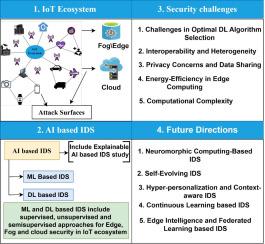揭示物联网生态系统安全:智能入侵防御、趋势、挑战和未来方向综述
IF 4.9
3区 计算机科学
Q1 COMPUTER SCIENCE, HARDWARE & ARCHITECTURE
引用次数: 0
摘要
物联网(IoT)设备使用的快速增长已经改变了日常生活和医疗保健、交通和智能家居等行业。然而,这些设备通常资源有限,依赖于跨边缘、雾层和云层的通信,从而产生了攻击者可以利用的漏洞。本文全面回顾了为物联网安全量身定制的智能入侵检测系统(IDS),重点介绍了利用人工智能(AI)、机器学习(ML)和深度学习(DL)的解决方案。我们分析了物联网设备的现有IDS方法,以及跨边缘、雾层和云层的安全通信,突出了它们的优势和局限性。此外,我们确定了边缘计算的关键研究挑战包括计算复杂性,实时适应性和能源效率。为了解决这些差距,我们提出了未来的研究方向,包括用于超快速IDS的神经形态计算,自进化AI驱动的IDS,超个性化异常检测,用于隐私保护安全的联邦学习,以及用于人类AI协作的可解释AI (XAI)。通过整合这些创新,我们设想下一代IDS解决方案,为动态物联网生态系统提供可扩展、可解释和节能的安全框架。本文章由计算机程序翻译,如有差异,请以英文原文为准。

Unveiling IoT ecosystem security: A review of intelligent IDS, trends, challenges, and future directions
The rapid increase in the use of Internet of Things (IoT) devices has transformed everyday life and industries such as healthcare, transportation, and smart homes. However, these devices, often limited in resources, depend on communication across edge, fog, and cloud layers, creating vulnerabilities that attackers can exploit. This paper provides a comprehensive review of intelligent intrusion detection system (IDS) tailored for IoT security, focusing on solutions that utilize Artificial Intelligence (AI), Machine Learning (ML), and Deep Learning (DL). We analyze existing IDS approaches for IoT devices and secure communication across the edge, fog, and cloud layers, highlighting their strengths and limitations. Additionally, we identify Key research challenges include computational complexity, real-time adaptability, and energy efficiency in Edge Computing. To address these gaps, we propose future research directions, including neuromorphic computing for ultra-fast IDS, self-evolving AI-driven IDS, hyper-personalized anomaly detection, federated learning for privacy- preserving security, and explainable AI (XAI) for human–AI collaboration. By integrating these innovations, we envision next-generation IDS solutions that offer scalable, interpretable, and energy- efficient security frameworks for the dynamic IoT ecosystem.
求助全文
通过发布文献求助,成功后即可免费获取论文全文。
去求助
来源期刊

Computers & Electrical Engineering
工程技术-工程:电子与电气
CiteScore
9.20
自引率
7.00%
发文量
661
审稿时长
47 days
期刊介绍:
The impact of computers has nowhere been more revolutionary than in electrical engineering. The design, analysis, and operation of electrical and electronic systems are now dominated by computers, a transformation that has been motivated by the natural ease of interface between computers and electrical systems, and the promise of spectacular improvements in speed and efficiency.
Published since 1973, Computers & Electrical Engineering provides rapid publication of topical research into the integration of computer technology and computational techniques with electrical and electronic systems. The journal publishes papers featuring novel implementations of computers and computational techniques in areas like signal and image processing, high-performance computing, parallel processing, and communications. Special attention will be paid to papers describing innovative architectures, algorithms, and software tools.
 求助内容:
求助内容: 应助结果提醒方式:
应助结果提醒方式:


